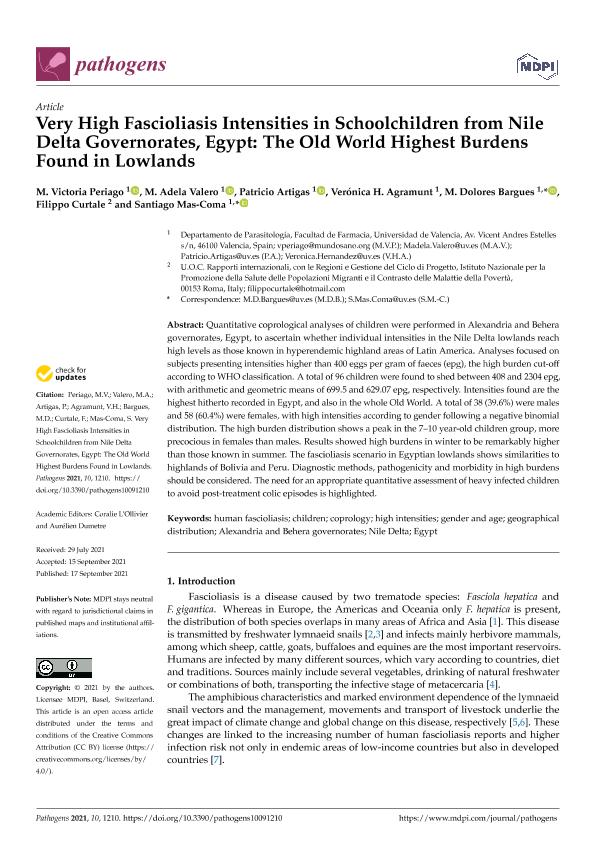Mostrar el registro sencillo del ítem
dc.contributor.author
Periago, Maria Victoria

dc.contributor.author
Adela Valero, M.
dc.contributor.author
Artigas, Patricio
dc.contributor.author
Agramunt, Verónica H.
dc.contributor.author
Bargues, M. Dolores
dc.contributor.author
Curtale, Filippo
dc.contributor.author
Mas-Coma, Santiago

dc.date.available
2022-08-23T12:12:52Z
dc.date.issued
2021-09
dc.identifier.citation
Periago, Maria Victoria; Adela Valero, M.; Artigas, Patricio; Agramunt, Verónica H.; Bargues, M. Dolores; et al.; Very high fascioliasis intensities in schoolchildren from nile delta governorates, egypt: The old world highest burdens found in lowlands; Multidisciplinary Digital Publishing Institute; Pathogens; 10; 9; 9-2021; 1-20
dc.identifier.uri
http://hdl.handle.net/11336/166298
dc.description.abstract
Quantitative coprological analyses of children were performed in Alexandria and Behera governorates, Egypt, to ascertain whether individual intensities in the Nile Delta lowlands reach high levels as those known in hyperendemic highland areas of Latin America. Analyses focused on subjects presenting intensities higher than 400 eggs per gram of faeces (epg), the high burden cut-off according to WHO classification. A total of 96 children were found to shed between 408 and 2304 epg, with arithmetic and geometric means of 699.5 and 629.07 epg, respectively. Intensities found are the highest hitherto recorded in Egypt, and also in the whole Old World. A total of 38 (39.6%) were males and 58 (60.4%) were females, with high intensities according to gender following a negative binomial distribution. The high burden distribution shows a peak in the 7–10 year-old children group, more precocious in females than males. Results showed high burdens in winter to be remarkably higher than those known in summer. The fascioliasis scenario in Egyptian lowlands shows similarities to highlands of Bolivia and Peru. Diagnostic methods, pathogenicity and morbidity in high burdens should be considered. The need for an appropriate quantitative assessment of heavy infected children to avoid post-treatment colic episodes is highlighted.
dc.format
application/pdf
dc.language.iso
eng
dc.publisher
Multidisciplinary Digital Publishing Institute
dc.rights
info:eu-repo/semantics/openAccess
dc.rights.uri
https://creativecommons.org/licenses/by/2.5/ar/
dc.subject
ALEXANDRIA AND BEHERA GOVERNORATES
dc.subject
CHILDREN
dc.subject
COPROLOGY
dc.subject
EGYPT
dc.subject
GENDER AND AGE
dc.subject
GEOGRAPHICAL DISTRIBUTION
dc.subject
HIGH INTENSITIES
dc.subject
HUMAN FASCIOLIASIS
dc.subject
NILE DELTA
dc.subject.classification
Otras Ciencias Biológicas

dc.subject.classification
Ciencias Biológicas

dc.subject.classification
CIENCIAS NATURALES Y EXACTAS

dc.title
Very high fascioliasis intensities in schoolchildren from nile delta governorates, egypt: The old world highest burdens found in lowlands
dc.type
info:eu-repo/semantics/article
dc.type
info:ar-repo/semantics/artículo
dc.type
info:eu-repo/semantics/publishedVersion
dc.date.updated
2022-08-18T15:54:49Z
dc.identifier.eissn
2076-0817
dc.journal.volume
10
dc.journal.number
9
dc.journal.pagination
1-20
dc.journal.pais
Suiza

dc.journal.ciudad
Basel
dc.description.fil
Fil: Periago, Maria Victoria. Fundación Mundo Sano; Argentina. Consejo Nacional de Investigaciones Científicas y Técnicas; Argentina. Universidad de Valencia; España
dc.description.fil
Fil: Adela Valero, M.. Universidad de Valencia; España
dc.description.fil
Fil: Artigas, Patricio. Universidad de Valencia; España
dc.description.fil
Fil: Agramunt, Verónica H.. Universidad de Valencia; España
dc.description.fil
Fil: Bargues, M. Dolores. Universidad de Valencia; España
dc.description.fil
Fil: Curtale, Filippo. Istituto Nazionale Per la Promozione Della Salute; Italia
dc.description.fil
Fil: Mas-Coma, Santiago. Universidad de Valencia; España
dc.journal.title
Pathogens
dc.relation.alternativeid
info:eu-repo/semantics/altIdentifier/url/https://www.mdpi.com/2076-0817/10/9/1210
dc.relation.alternativeid
info:eu-repo/semantics/altIdentifier/doi/http://dx.doi.org/10.3390/pathogens10091210
Archivos asociados
